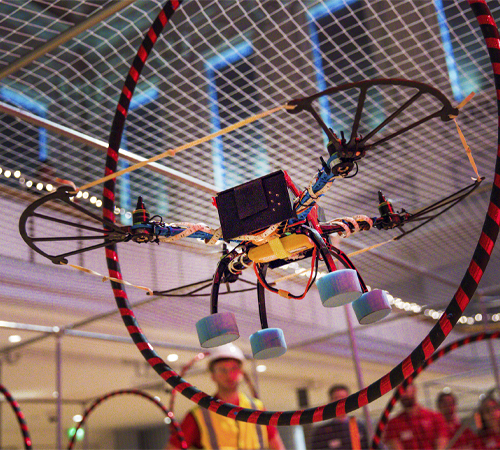
The aim of our resources is to inspire the next generation of engineers by showcasing how STEM skills can positively impact society.
Drone: friend or foe? invites students to explore the fascinating world of drones and their impact on society. This resource includes a teacher guide, a set of six themed activities and two associated case studies
- What is a drone?
- Thinking like a drone - with supporting track worksheets
- Optimal propellor
- Safe delivery
- Remote data - with bitmap grid worksheet
- Missing drone
Students can explore the world of engineering and learn about the diverse roles engineers play, while developing essential transferable skills such as problem solving, teamwork, communication and social awareness.
Resources
What is a drone?
The What is a Drone? activity is designed as an introduction to the uses of drones, aimed at dispelling the myth that they are just weapons or toys. In fact, they have wider ranging practical, civil, humanitarian and commercial applications.
Activity 2: Mathematics
- KS4 Geometry and measures: interpret and use bearings.
Activity 3: Science
- KS4 Working scientifically: appreciating the power and limitations of science and considering ethical issues which may arise; explaining everyday and technological applications of science; evaluating associated personal, social, economic and environmental implications; and making decisions based on the evaluation of evidence and arguments.
Thinking like a drone
This activity is based around line-tracking robots to get students thinking about sensors. It includes several problem-solving activities and discussions.
Download the Thinking like a drone activity and the Drone tracks worksheet.
Activity 1: Computing
- KS3 & 4 Develop and apply their analytic, problem solving, design and computational thinking skills.
Stretch and challenge 1: Design & technology
- KS3 Evaluate: test, evaluate and refine their ideas and products against a specification.
Activity 2: Mathematics
- KS3 Ratio, proportion and rates of change: use scale factors, scale diagrams and maps; use ratio notation.
- KS4 Ratio, proportion and rates of change: compare lengths, areas and volumes using ratio notation and/or scale factors.
Stretch and challenge 2: Design & technology
- KS3 Evaluate: test, evaluate and refine their ideas and products against a specification.
The optimal propeller
The Optimal propeller activity is designed to be a practical way to explore the physics of lift, with stretch and challenge activities to get students working scientifically.
Activity 2: Science
- KS3 & 4 Working scientifically: experimental skills and strategies.
Activity 3: Science
- KS3 Working scientifically: analysis and evaluation.
Stretch and challenge activity 1: Science
- KS3 Working scientifically: experimental skills and strategies; analysis and evaluation.
Stretch and challenge activity 2: Science
- KS3 Evaluate: test, evaluate and refine their ideas and products against a specification.
- KS4: use and interpret scatter graphs of bivariate data; recognise correlation and know that it does not indicate causation; draw estimated lines of best fit.
Safe delivery
The Safe delivery activity is based on the idea that drones could be used as delivery vehicles. It looks both theoretically and practically at the engineering involved in creating a safe way to deliver goods and humanitarian aid.
Activity 1: Science
- KS3 Forces: non-contact forces.
- KS4 Forces: Forces as vectors.
- KS4 Forces and motion: acceleration caused by forces.
- KS4 Energy: conservation of energy in a closed system.
Activity 2 Design & technology
- KS3 Forces: Non-contact forces.
- KS4 Forces: Forces as vectors.
- KS4 Forces and motion: acceleration caused by forces.
- KS4 Energy: conservation of energy in a closed system.
- KS3 Evaluate: test, evaluate and refine their ideas and products against a specification.
Stretch and challenge Science: Mathematics
- KS4 Forces: Forces as vectors.
- KS4 Forces and Motion: acceleration cause by forces.
- KS4 Energy: conservation of energy in a closed system.
- KS4 Solving problems: model situations mathematically
- Algebra: Simplify and manipulate algebraic equations.
Remote data
This resource is based around how space probes send data they have hand collected back to earth. The activities explore the science and computing involved in collecting, sending and interpreting data from remote locations.manitarian aid.
Download the Remote data activity and bitmap grid worksheet for this activity.
Activity 1 and 2: Computing
- KS3 & 4 Understand how numbers can be represented in binary
- KS3 & 4: Understand how data of various types can be represented and manipulated digitally in the form of binary digits'
Activity 3: Science
- KS3 Light waves
Activity 4: Computing: Science
- KS3 & 4: Understand how numbers can be represented in binary
- KS3 & 4: Understand how data of various types can be represented and manipulated digitally, in the form of binary digits
- KS3 & 4: Wave motion
Missing drones
The Missing drones activity is designed as an introduction to the mathematics involved in GPS location.
Activity 1: Mathematics
- KS3 & 4: Geometry and measure.
Stretch and challenge: Mathematics and Science
- KS3 & 4: Geometry and measure.
- KS3: Describing motion speed and the quantitative relationship between average speed, distance and time (speed = distance / time).
Activity 2: Mathematics
- KS3 & 4: Geometry and measure.
More education resources
STEM Teaching Resources
The Academy's engineering-themed learning and teaching resources have been developed in partnership with teachers and e…
Engineering habits quiz
Engineers create or improve things using specific 'engineering habits.' Take the quiz to discover your habits now. Reme…
Education and Skills
The Academy education and skills activities are focused on addressing the UK’s engineering skills challenge. We work ac…
